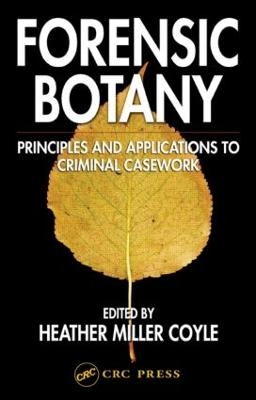
Forensic Botany
Crc Press Inc (Verlag)
978-0-8493-1529-9 (ISBN)
- Lieferbar
- Versandkostenfrei
- Auch auf Rechnung
- Artikel merken
Increasingly, forensic scientists use plant evidence to reconstruct crimes. The forensic aspects of this subject require an understanding of what is necessary for botanical evidence to be accepted in our judicial system.
Bringing together the latest information into a single resource, Forensic Botany: Principles and Applications to Criminal Casework introduces the basic science underlying this emerging field of forensic botany. Contributors discuss the recognition of pertinent plant evidence at a crime scene, the appropriate collection and preservation of the material, and maintenance of a chain of custody. They also explain scientific testing methods, the validation of new forensic techniques, and admissibility criteria for court. An overview of plant biology and historical developments in forensic DNA analysis is also included, as well as case examples featuring the use of botanical evidence in a variety of criminal cases.
In an effort to build the scientific foundation for this promising field, this book provides definitive coverage of forensic botany with detailed applications and case examples. It familiarizes forensic scientists with the role of botanical evidence in criminal investigations and its potential value in the pursuit of justice.
Heather Miller Coyle
Introduction. Basic Plant Biology. Plant Cell Structure and Function. Modes of Plant Reproduction. DNA Structure and Function. Plant Diversity. The Use of Biological and Botanical Evidence in Criminal Investigations. An Overview of Historical Developments in Forensic DNA Analysis. DNA and the Identification of Plant Species from Stomach Contents. Plant Identification by DNA. Case Applications of Forensic Botany. Tracking Clonally Propagated Marijuana Using Amplified Fragment Length Polymorphism (AFLP) Analysis. Legal Considerations for Acceptance of New Forensic Methods in Court. Forensic Palynology. Classical and Future DNA Typing Technologies for Plants. Appendix 1: Considerations for the Use of Forensic Botanical Evidence: An Overview. Appendix 2: Glossary of Terms. Appendix 3: Directory of Contacts. Appendix 4: Biographies.
| Erscheint lt. Verlag | 15.9.2004 |
|---|---|
| Zusatzinfo | 19 Tables, black and white; 21 Halftones, black and white; 8 Illustrations, color; 82 Illustrations, black and white |
| Verlagsort | Bosa Roca |
| Sprache | englisch |
| Maße | 156 x 234 mm |
| Gewicht | 616 g |
| Themenwelt | Naturwissenschaften ► Biologie ► Botanik |
| Recht / Steuern ► Strafrecht ► Kriminologie | |
| Weitere Fachgebiete ► Land- / Forstwirtschaft / Fischerei | |
| ISBN-10 | 0-8493-1529-8 / 0849315298 |
| ISBN-13 | 978-0-8493-1529-9 / 9780849315299 |
| Zustand | Neuware |
| Informationen gemäß Produktsicherheitsverordnung (GPSR) | |
| Haben Sie eine Frage zum Produkt? |
aus dem Bereich



